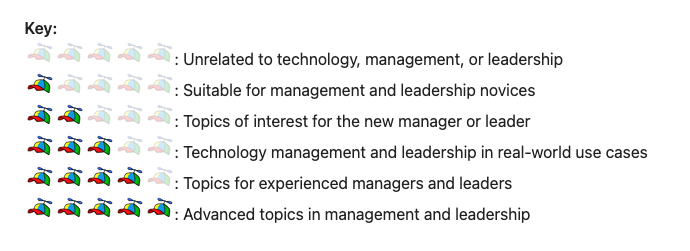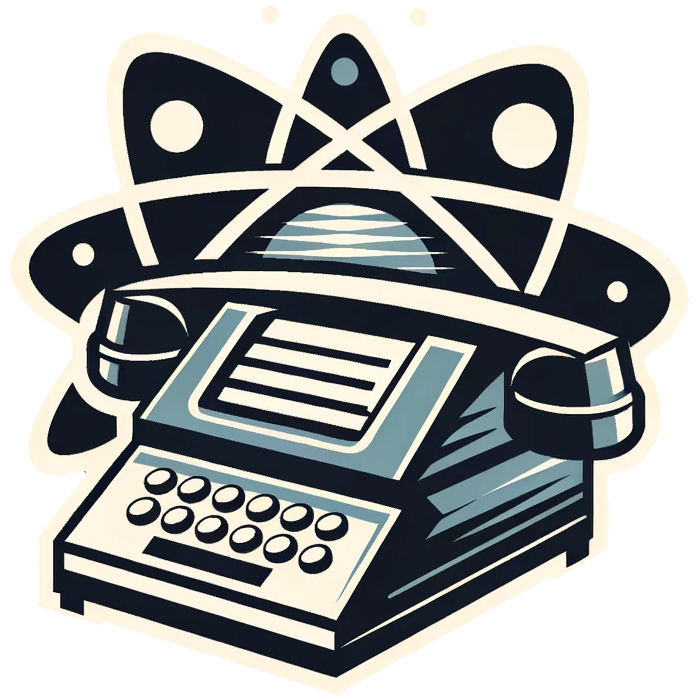QFM059: Engineering Leadership Reading List March 2025
Everything that I found interesting last month about engineering leadership.
Tags: qfm, engineering, leadership, reading, list, march, 2025
 Source: Photo by Mathias Jensen on Unsplash
Source: Photo by Mathias Jensen on Unsplash
This month’s Engineering Leadership Reading List starts with a quiet dismantling of the ‘10x engineer’ myth in In Praise of ‘Normal’ Engineers. This reframes engineering excellence as a function of team design rather than individual brilliance. The piece advocates for organisational environments that allow capable, consistent engineers to thrive-—echoing themes of structural support over star power found in The Product Engineer, where engineering and design talent are positioned as central to product decisions, often in tension with traditional PM-led models.
As engineering leadership increasingly intersects with organisational dynamics, Career Development: What It Really Means to be a Manager, Director, or VP cuts through the abstraction of title inflation and formal levelling systems. It instead grounds career growth in accountability and strategic execution. A similar realism runs through Career advice in 2025, which examines the uncertainty many leaders face in a tech landscape shaped by AI hype, funding constraints, and shifting talent markets.
The tension between AI capability and engineering identity features prominently across several pieces. The Software Engineering Identity Crisis and AI is Making Developers Dumb both ask what it means to be a software engineer in a world where large language models shoulder an increasing share of implementation detail. These concerns are not only about productivity but also about what knowledge should be retained, cultivated, or relinquished in a human-AI partnership.
The end of YC takes a longer view, exploring how AI tooling erodes the historic advantage of deeply technical founders, shifting the balance in favour of domain experts with strong product intuition. This democratisation of development also underpins the argument in The Rise of the GTM Engineer, where engineering talent is increasingly directed at commercial functions—embedding technical fluency directly into go-to-market operations, driven by automation and data.
Process and practice remain enduring concerns, with A blueprint for modern product development offering a structured approach for organisations seeking to scale product efforts without defaulting to rigid governance. The blueprint emphasises continuous discovery and pragmatic iteration—building discipline into flexibility. And in Stanford CS109 Probability for Computer Scientists Lecture, we’re reminded that solid foundations—in this case, probability theory—still matter, even as higher-order tools abstract away many of the details.
As always, the Quantum Fax Machine Propellor Hat Key will guide your browsing. Enjoy!


 In Praise of ‘Normal’ Engineers: The article critiques the myth of the ‘10x engineer’, who is solely credited with bringing tremendous value to tech projects. It challenges the practicality of measuring productivity and emphasizes the importance of team collaboration over individual accomplishments. The author argues that great engineering teams are those where ‘normal’ engineers can perform well and have a consistent impact, without relying solely on exceptional talents. It suggests that organizations that empower average engineers often produce world-class engineers.
In Praise of ‘Normal’ Engineers: The article critiques the myth of the ‘10x engineer’, who is solely credited with bringing tremendous value to tech projects. It challenges the practicality of measuring productivity and emphasizes the importance of team collaboration over individual accomplishments. The author argues that great engineering teams are those where ‘normal’ engineers can perform well and have a consistent impact, without relying solely on exceptional talents. It suggests that organizations that empower average engineers often produce world-class engineers.
#Engineering #SoftwareDevelopment #TechTeams #Collaboration #Productivity

 A blueprint for modern product development: The article discusses the challenges and best practices of modern product development, focusing on the importance of standardization as companies grow. It argues against the Taylorist approach for software, since modern development needs to be adaptive and iterative. The blueprint offered provides a process involving capture, discovery, delivery, and rollout, aimed primarily at scale-ups and enterprises to enhance predictability and ROI. The principles of continuous discovery and delivery, minimizing governance, and relying on evidence over opinions are emphasized, all within a flexible structure to accommodate varying scales of solution complexity.
A blueprint for modern product development: The article discusses the challenges and best practices of modern product development, focusing on the importance of standardization as companies grow. It argues against the Taylorist approach for software, since modern development needs to be adaptive and iterative. The blueprint offered provides a process involving capture, discovery, delivery, and rollout, aimed primarily at scale-ups and enterprises to enhance predictability and ROI. The principles of continuous discovery and delivery, minimizing governance, and relying on evidence over opinions are emphasized, all within a flexible structure to accommodate varying scales of solution complexity.
#ProductDevelopment #Agile #DevOps #SoftwareEngineering #Innovation

 Career advice in 2025: In this complex landscape of 2025, technology transitions and market shifts are challenging careers, particularly in tech leadership roles. The shift towards foundational models and AI is invalidating many traditional management playbooks, leading to less enthusiasm among leaders who thrived under previous paradigms focused on team growth and motivation. As valuations and funding become more stringent, career paths have become unpredictable, especially outside AI-focused enterprises, resulting in tough competition and limited opportunities.
Career advice in 2025: In this complex landscape of 2025, technology transitions and market shifts are challenging careers, particularly in tech leadership roles. The shift towards foundational models and AI is invalidating many traditional management playbooks, leading to less enthusiasm among leaders who thrived under previous paradigms focused on team growth and motivation. As valuations and funding become more stringent, career paths have become unpredictable, especially outside AI-focused enterprises, resulting in tough competition and limited opportunities.
#CareerAdvice #FutureOfWork #AIFuture #TechLeadership #JobMarket2025

 The end of YC: AI-driven development tools have reduced the barriers to building software, allowing non-engineers to rapidly prototype and test ideas without traditional technical expertise. This shift challenges Silicon Valley’s model of favouring technologists over domain experts, potentially leading to a future where product success is determined more by deep industry knowledge and taste than engineering skill.
The end of YC: AI-driven development tools have reduced the barriers to building software, allowing non-engineers to rapidly prototype and test ideas without traditional technical expertise. This shift challenges Silicon Valley’s model of favouring technologists over domain experts, potentially leading to a future where product success is determined more by deep industry knowledge and taste than engineering skill.
#AI #SoftwareDevelopment #Startups #NoCode #TechDemocratisation

 The Rise of the GTM Engineer: Go-to-market (GTM) Engineers are emerging as a crucial role in adapting to the rapidly evolving landscape of technology-driven sales and marketing. This article, co-published by Brendan J Short and Jason Saltzman, explores the significance of this new role. GTM Engineers leverage AI, automation, and data analytics to optimize sales strategies and enhance customer engagement throughout the entire lifecycle, from lead generation to customer retention. The piece highlights major industry trends that contribute to the rise of GTM engineering, such as AI-driven personalization and sales automation, and provides insights into why this role may become integral for future business successes.
The Rise of the GTM Engineer: Go-to-market (GTM) Engineers are emerging as a crucial role in adapting to the rapidly evolving landscape of technology-driven sales and marketing. This article, co-published by Brendan J Short and Jason Saltzman, explores the significance of this new role. GTM Engineers leverage AI, automation, and data analytics to optimize sales strategies and enhance customer engagement throughout the entire lifecycle, from lead generation to customer retention. The piece highlights major industry trends that contribute to the rise of GTM engineering, such as AI-driven personalization and sales automation, and provides insights into why this role may become integral for future business successes.
#GTMEngineer #SalesAutomation #AI #DataAnalytics #TechInnovation

 Stanford CS109 Probability for Computer Scientists Lecture: Stanford University offers an engaging video lecture titled ‘CS109 Probability for Computer Scientists I Counting I 2022 I Lecture 1’. This video is designed for computer science students to gain a foundational understanding of probability and counting principles. Led by Assistant Professor Chris Piech, the lecture provides a comprehensive introduction to the subject, aligning with the course’s curriculum available on Stanford’s website.
Stanford CS109 Probability for Computer Scientists Lecture: Stanford University offers an engaging video lecture titled ‘CS109 Probability for Computer Scientists I Counting I 2022 I Lecture 1’. This video is designed for computer science students to gain a foundational understanding of probability and counting principles. Led by Assistant Professor Chris Piech, the lecture provides a comprehensive introduction to the subject, aligning with the course’s curriculum available on Stanford’s website.
#Stanford #CS109 #Probability #ComputerScience #Education

 The Software Engineering Identity Crisis: Annie Vella explores the evolving identity of software engineers in an era dominated by AI coding assistants. The article discusses how the use of AI is transforming engineers from creators to overseers, raising fundamental questions about professional identity and satisfaction. As AI takes on more coding tasks, engineers need to focus on higher-level design and communication skills, challenging the traditional craft of coding and urging adaptation to maintain their essence as builders.
The Software Engineering Identity Crisis: Annie Vella explores the evolving identity of software engineers in an era dominated by AI coding assistants. The article discusses how the use of AI is transforming engineers from creators to overseers, raising fundamental questions about professional identity and satisfaction. As AI takes on more coding tasks, engineers need to focus on higher-level design and communication skills, challenging the traditional craft of coding and urging adaptation to maintain their essence as builders.
#SoftwareEngineering #AI #IdentityCrisis #Technology #Coding

 AI is Making Developers Dumb: The article explores the dichotomy of using LLMs in software engineering, highlighting both productivity gains and the risk of dependence that can limit knowledge retention. Over-reliance on tools like GitHub’s Copilot may lead to “Copilot Lag,” where engineers become passive, awaiting direction from AI rather than engaging in the problem-solving process themselves. While LLMs serve as powerful aids when used judiciously; they should not replace the foundational understanding necessary for true innovation and skill development.
AI is Making Developers Dumb: The article explores the dichotomy of using LLMs in software engineering, highlighting both productivity gains and the risk of dependence that can limit knowledge retention. Over-reliance on tools like GitHub’s Copilot may lead to “Copilot Lag,” where engineers become passive, awaiting direction from AI rather than engaging in the problem-solving process themselves. While LLMs serve as powerful aids when used judiciously; they should not replace the foundational understanding necessary for true innovation and skill development.
#AI #SoftwareEngineering #LLM #Copilot #Innovation

 The Product Engineer: “The Product Engineer” by Rands in Repose argues against the necessity of Product Managers in consumer software companies. It highlights the power struggle between Engineering, Design, and Product Management, advocating for a more integrated role for engineers, designers, and a new concept of a Product Engineer who embodies both technical knowledge and product vision. The article discusses common pitfalls in product development such as ‘Product Managers as CEOs’ and ‘Uncompromising Designers’ and proposes that builders should have a significant voice in product decisions.
The Product Engineer: “The Product Engineer” by Rands in Repose argues against the necessity of Product Managers in consumer software companies. It highlights the power struggle between Engineering, Design, and Product Management, advocating for a more integrated role for engineers, designers, and a new concept of a Product Engineer who embodies both technical knowledge and product vision. The article discusses common pitfalls in product development such as ‘Product Managers as CEOs’ and ‘Uncompromising Designers’ and proposes that builders should have a significant voice in product decisions.
#ProductManagement #SoftwareDevelopment #Engineering #Design #ProductEngineer

 Career Development: What It Really Means to be a Manager, Director, or VP: The article discusses the nuances of career development within management roles such as Manager, Director, and VP. It critiques standard big-company HR practices like leveling, arguing for a more results-oriented and realistic approach to management roles and responsibilities. The author emphasizes the importance of accountability and strategic planning at each managerial level, advising against blindly following hierarchical leveling systems in favor of meaningful career progression.
Career Development: What It Really Means to be a Manager, Director, or VP: The article discusses the nuances of career development within management roles such as Manager, Director, and VP. It critiques standard big-company HR practices like leveling, arguing for a more results-oriented and realistic approach to management roles and responsibilities. The author emphasizes the importance of accountability and strategic planning at each managerial level, advising against blindly following hierarchical leveling systems in favor of meaningful career progression.
#CareerDevelopment #Leadership #Management #Startups #HR
Regards,
M@
[ED: If you’d like to sign up for this content as an email, click here to join the mailing list.]
Originally published on quantumfaxmachine.com and cross-posted on Medium.
hello@matthewsinclair.com | matthewsinclair.com | bsky.app/@matthewsinclair.com | masto.ai/@matthewsinclair | medium.com/@matthewsinclair | xitter/@matthewsinclair |
